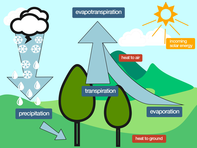Water can be present in three forms - in solid form as ice, as a liquid, or in the form of gas as water vapour. Evaporation is the process whereby liquid water is converted to water vapour.

What Causes Evaporation?
In the process, water is removed from the evaporating surface - surfaces like oceans, lakes, rivers, soils and wet vegetation. Evaporation from oceans or lakes will lead to rain, but evaporation from storage dams built to provide water for irrigation is a problem. Big, shallow dams in hot, dry areas are relatively inefficient.
Energy is required to change water molecules from liquid to vapour. The sun’s rays provide this energy, but there are a few factors that determine the rate of evaporation.
Temperature. Higher temperatures increase evaporation.
Humidity. Dry air increases evaporation.
Wind. A hot, dry wind will replace moist air and results in faster evaporation. This is an important factor in Lower Orange River, Vaalharts, Riet River and Sandvet irrigation schemes and in farming areas subject to berg winds. Cool, moist winds from a cold ocean increase humidity and reduce evaporation rates.
Evaporation and South Africa's Climate
South Africa lies in the mid-latitudes. These temperate zones lie about 30 to 60 degrees south, and north, of the equator. In addition, South Africa has high temperatures and low humidities, all contributing factors to a very high evaporation rate.
Potential evaporation in farming areas receiving 500 mm rain per year is between about 2 000 and 2 600 mm per year. Compare this to an area in central Europe, which receives the same annual rainfall. This area has a potential evaporation rate of only 300 mm per annum, a much higher rainfall efficiency.
In South Africa evaporation ranges from less than 1 400 mm per year in the Drakensberg/Maluti areas to more than 2 800 mm per year in parts of the Kalahari. There is more-or-less an inverse relationship between average rainfall and average evaporation; the higher the rainfall, the lower the evaporation.
It is important to note that very high potential evaporation rates are in the areas of major irrigation schemes in South Africa, like the Lower Orange River, Vaalharts, Douglas, Rama and Barkley West areas.
Evaporation and Soil
The water content of the soil has an important impact on evaporation loss. Evaporation is also mainly from the top 15 to 20 cm layer of soil. Evaporation takes place much faster from the soil surface in soil with a water content close to field capacity.
The field capacity of soil is the water left in the soil after excess water has drained away. Large pores in the soil are filled with air and water while the smaller pores are still full of water. When irrigating, try to reduce evaporation. You can do this by increasing the field capacity of the soil.
Apply as much water per irrigation and wait as long as you can before irrigating again - long intervals between irrigations. Consider the limitations of the crop’s water requirements. This increases the period during which soil is near field capacity and can, in turn, reduce evaporation.
However, just keeping the soil surface wet by frequent light irrigations results in a high evaporation loss. Mulches and similar soil covers can be used to reduce evaporation from surface soil.
Evapotranspiration
Evaporation and transpiration occur at the same time. Evaporation is the loss of water from the (soil) surface while transpiration is the loss of water in the form of water vapour from a plant’s leaves. At sowing, nearly all of the evapotranspiration is evaporation from the soil surface, but as the crop grows more of the soil surface is shaded by the crop’s leaves.
At full leaf cover, more than 90% of evapotranspiration comes from transpiration. Potential evapotranspiration is the evapotranspiration rate from a hypothetical grass reference surface with specific characteristics and which is never short of water. This is used as a standard to measure against the water requirement of all other crops.
Source Water Research Commission